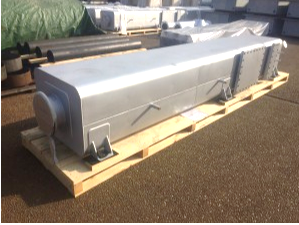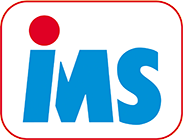IMS designed and supplied six SCR systems for an overseas client in 2017.
The emissions target was to reduce NOx emissions from 4661mg/Nm3 @ 5% O2 to lower than 600mg/Nm3 @5% 02 which meant a reduction of approximately -87%.
CO needed to be reduced from 767mg/Nm3 @ 5% O2 to below 250mg/Nm3 @5% O2 a reduction of -67%.
HC needed to be reduced from 158mg/Nm3 @ 5% O2 to below 50mg/Nm3 @5% O2 a reduction of -68%.
Soot particles were not to be increased as a resut of using the SCR Technology.
Following commissioning of each system the Nox levels were reduced by an average of around -90% across all 6 systems, whereas the CO and HC was reduced by a factor of around -76%.
The photograph below shows one of the SCR Reactors with built in silencing and spark arresting capabilities designed for the client.

As well as the combined SCR reactor, exhaust silencer/spark arrestor the system was supplied with 1,350 Ltr AdBlue Tanks (client specification) urea dosing pump, transfer pipes and AdBlue injector.
The external mixing pipes (not shown) was manufactured in Stainless Steel grade.
The SCR catalytic elements were square in section and came with a control panel with a programmable controller and a wide array of sensors including pressure, temperature, NOx and Back Pressure sensors.
The combined SCR + Silencer/Spark Arrestor was designed to replace the existing silencer on the Cummins VTA28-G5 engine on the standby generators.
Details of the Cummins VTA28-G5 Engines:
Engine Type: Cummins VTA28-G3 (4-cycle, T/C, A/C)
Fuel Type: Diesel Powered (EN590)
Configuration: 12 in-line
Engine Capacity: 28 Ltr
Bore and Stroke: 140mm x 152mm
Rated Speed: 1500rpm
Power Rating: 560 Kw (Prime)
Power Rating: 612 Kw (Standby)
Electrical Rating: 636 KVA (Prime)
Electrical Rating: 700 KVA (Prime)
Exhaust Temp: 480C
Fuel Consumption: 154 l/h at 100% Prime Power
AdBlue Consumption: 10 l/h at 100% Prime Power
The recommendation was to use no more than 50ppm ULSD Fuels to minimise any increase in particulates.
Opacity measurements were taken following installation and it was found that there was no significant difference in the PM measurements mainly due to switching to the ULSD.
To reduce the CO (Carbon Monoxides) and HC (Hydrocarbons) to the permitted levels shown above Diesel Oxidation Catalysts (DOCs) were installed prior to the SCR Catalysts.
Since supplying this type of system IMS have switched to using round substrates in a modular construction all in parallel which reduces the overall backpressure across the system.
This unit also had an external AdBlue Mixing Pipe which increases the length of the system. IMS now wherever possible uses an embedded mixer pipe with the reactor.
Also, the reactor used an air assisted AdBlue Injector which required a compressor to deliver the AdBlue and keep the injector cool.
Today, IMS uses an airless AdBlue injection system where the injector is cooled by recirculating the AdBlue across the injector.
We also now use both “Engine Out” and “Tailpipe” NOx Sensors (rather than a single NOx sensor on the outlet) as part of a closed loop system which continually monitors NOx reductions across the SCR Catalysts.
The complete system was designed and delivered by IMS but installed by a local partner based in Egypt.
